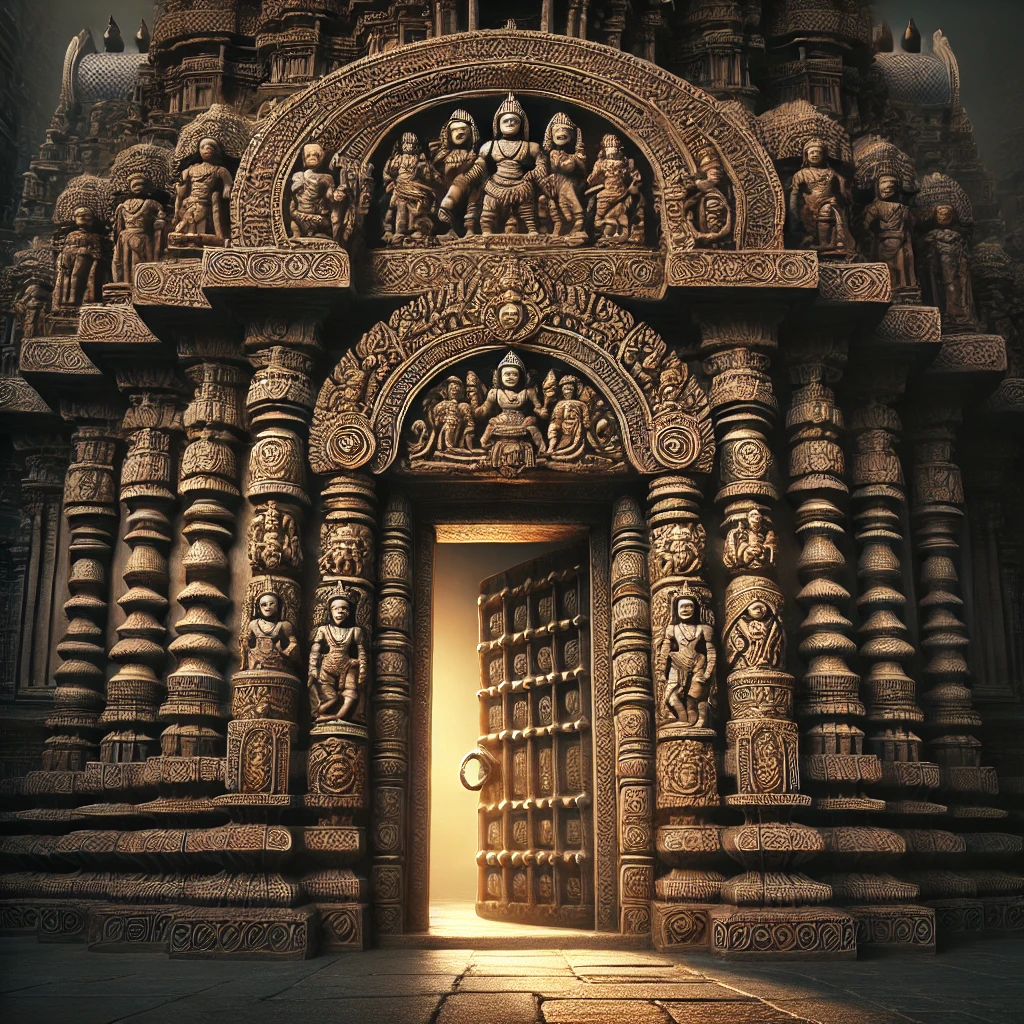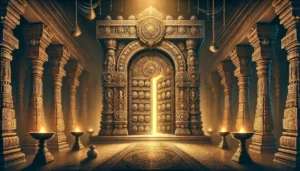
The Secret Door of Padmanabhaswamy Temple
The Origins of Padmanabhaswamy Temple
The Padmanabhaswamy Temple is not just a marvel of architecture but also a relic of India’s ancient spiritual traditions. Dedicated to Lord Vishnu, the temple is mentioned in texts like the Vishnu Purana and Skanda Purana, signifying its importance in Sanatan Dharma. The presiding deity, Lord Padmanabha, is depicted in the unique Anantha Shayana posture, reclining on the cosmic serpent Anantha (Adishesha). This imagery symbolizes eternal rest and the cycle of creation, preservation, and dissolution.
The temple has been a center of devotion and power for centuries, closely associated with the Travancore royal family, who consider themselves Dasas (servants) of Lord Padmanabha. It was their unwavering devotion that led to the accumulation of vast treasures as offerings to the deity.
Vault B: A Divine Enigma
Unlike the other vaults that have revealed unimaginable wealth, Vault B has remained a riddle. This chamber is said to be untouched for centuries, its sanctity protected by divine will and rituals. The entrance to Vault B is guarded by intricately designed stone doors adorned with serpent motifs, suggesting its mystical significance.
Devotees believe that the vault is not merely a repository of treasures but a portal to another realm. Ancient traditions hint at its connection to cosmic energies, with some claiming that the vault is guarded by celestial beings. The legends associated with Vault B go beyond mere material wealth, intertwining with the temple’s spiritual and mystical significance.
Table of Contents
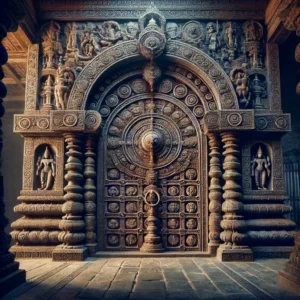
The Secret Door of Padmanabhaswamy Temple
Theories Surrounding Vault B
Vault B’s sealed nature has given rise to numerous theories:
- A Portal to Another Dimension: Some spiritual leaders and scholars propose that Vault B is not a physical repository but a gateway to another dimension or higher plane of existence. This theory aligns with the Sanatan Dharma’s concept of lokas (worlds) beyond human perception.
- A Curse to Protect the Vault: According to local lore, the vault is protected by a powerful curse placed by sages or celestial beings. Attempting to open it without the proper rituals is believed to unleash misfortune on those involved.
- Treasures Beyond Imagination: While other vaults revealed jewels, gold, and artifacts worth billions, many believe Vault B contains treasures far surpassing human imagination—perhaps ancient artifacts from a forgotten civilization or divine relics gifted by celestial beings.
- Mystical Energy Source: Esoteric traditions suggest that Vault B might house a source of immense cosmic energy, maintained by ancient rituals to ensure balance in the universe.
- An Empty Vault: Some skeptics believe Vault B might be empty, with its secrecy being a symbolic gesture rather than a practical one.
Failed Attempts and Divine Warnings
There have been attempts to explore Vault B, but all have met with resistance from religious authorities and devotees. On one occasion, it is said that efforts to force open the door were met with inexplicable occurrences, reinforcing the belief in divine protection.
The most intriguing aspect of Vault B is the Naga Bandham, an ancient tantric ritual said to seal the door. Only a sage well-versed in the Garuda Mantra is believed to possess the spiritual authority to unseal the chamber. Any deviation from this prescribed method is thought to invoke dire consequences.
Modern Science Meets Ancient Mysticism
While modern technology could potentially open Vault B, the resistance to such efforts stems from a deeper understanding of its spiritual significance. Unlike the other vaults, which were opened under Supreme Court supervision, Vault B is seen as a symbol of divine trust. The reluctance to open it is not merely about faith but also about respecting ancient traditions and cosmic balance.
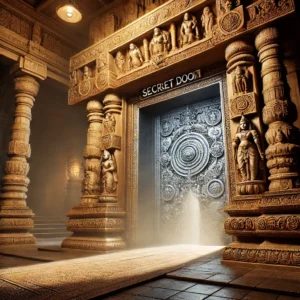
The Secret Door of Padmanabhaswamy Temple
Spiritual Implications of Vault B
Vault B is more than just a physical mystery; it carries profound spiritual symbolism. In Sanatan Dharma, the human body is often compared to a temple, with the mind and soul representing hidden chambers of wisdom. Vault B could symbolize the ultimate truth—Brahman—accessible only through devotion, discipline, and spiritual enlightenment.
The door is a reminder of the balance between material wealth and spiritual richness. It invites humanity to look beyond the materialistic and focus on the eternal, echoing the teachings of the Bhagavad Gita:
“Na chora haaryam, na cha raj haaryam, na bhratru bhaajyam, na cha bhaarakaari”
(“This wealth cannot be stolen by thieves, taken by kings, shared among brothers, or carried away by force—it is spiritual wisdom.”)
Cultural and Global Fascination
The Secret Door of Padmanabhaswamy Temple has attracted global attention. Historians, archaeologists, spiritual leaders, and even treasure hunters have shown interest in unraveling its mysteries. Yet, its sanctity and the respect it commands have ensured its preservation as an unsolved enigma.
Should Vault B Ever Be Opened?
The debate about whether to open Vault B continues to stir emotions. While some argue that uncovering its secrets could shed light on India’s ancient heritage, others caution against disturbing its sanctity. For devotees, the treasures and mysteries behind the door belong to Lord Padmanabha alone, reinforcing the belief that the material world is transient.
Conclusion: The Eternal Mystery
The Secret Door of Padmanabhaswamy Temple stands as a testament to the richness of India’s spiritual and cultural heritage. Whether it remains sealed forever or is opened someday, its significance transcends material wealth. It embodies the timeless mysteries of the universe, urging us to balance faith with curiosity and to honor the sanctity of what is sacred.
As we stand at the crossroads of science and spirituality, Vault B reminds us that some mysteries are better left untouched—treasures not of gold, but of faith, devotion, and the eternal quest for truth.
For more such fascinating explorations into the depths of Sanatan Dharma, mythology, and spirituality, visit Prachin Sanatan Yuga.
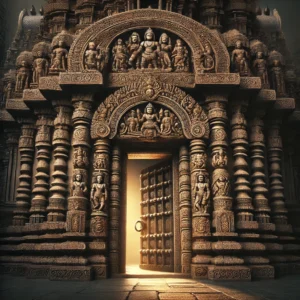
The Secret Door of Padmanabhaswamy Temple
FAQs on “The Secret Door of Padmanabhaswamy Temple: Unveiling the Mystery”
Q1: What is the Padmanabhaswamy Temple?
A: The Padmanabhaswamy Temple is an ancient Hindu temple located in Thiruvananthapuram, Kerala, dedicated to Lord Vishnu. Renowned for its Dravidian architectural style, it is considered one of the richest and most spiritually significant temples in the world.
Q2: What makes the Padmanabhaswamy Temple famous?
A: Apart from its spiritual importance, the temple is famous for its hidden underground vaults, five of which have revealed treasures worth billions. The unopened Vault B, in particular, has captivated global attention due to the myths and mysteries surrounding it.
Q3: What is Vault B in the Padmanabhaswamy Temple?
A: Vault B is one of the six underground chambers of the temple. Unlike the other vaults that have been opened, Vault B remains sealed and is considered highly sacred. It is believed to house untold riches and is protected by divine forces.
Q4: Why hasn’t Vault B been opened yet?
A: Vault B remains closed due to strong religious beliefs, ancient traditions, and myths that claim it is protected by divine powers. Opening it is believed to bring misfortune or calamity, and priests and devotees strongly oppose any attempts to unseal it.
Q5: Are there any historical records about Vault B?
A: Historical records suggest that Vault B has remained sealed for centuries, and its sanctity has been maintained by successive generations of temple custodians. Legends also claim that the door of Vault B is guarded by a mystical “Naga Bandham” (serpent seal) that can only be opened through specific mantras and rituals.
Q6: What is the significance of the treasures found in the other vaults?
A: The treasures discovered in the other vaults include gold coins, diamond-studded jewelry, precious stones, golden idols, and ceremonial artifacts. These treasures are considered offerings made by kings, devotees, and rulers over centuries to Lord Vishnu.
Q7: What myths are associated with Vault B?
A: There are several myths associated with Vault B, including:
It is guarded by divine beings or supernatural forces.
Opening it without proper rituals could unleash a curse.
The immense wealth inside is said to be beyond human comprehension.
Serpents and other mystical beings are believed to protect the vault.
Q8: Has any attempt been made to open Vault B?
A: In 2011, the Supreme Court of India ordered the opening of the temple’s vaults to catalog the treasures. However, Vault B was not opened due to resistance from devotees and priests who argued that it would violate the temple’s sanctity and pose spiritual risks.
Q9: How does the Padmanabhaswamy Temple protect its treasures?
A: The temple employs high-level security systems, including surveillance cameras, armed guards, and modern technology, to safeguard its treasures. Additionally, the temple’s spiritual and cultural traditions also act as a deterrent to potential threats.
Q10: What is the cultural and religious importance of the temple?
A: The temple is a major pilgrimage site for Hindus and is revered as one of the 108 Divya Desams (sacred Vishnu temples). Its rich history, spiritual significance, and connection to the royal family of Travancore make it a symbol of Kerala’s cultural heritage.
Q11: Why is the wealth of the temple not utilized for public welfare?
A: The treasures of the temple are considered sacred property belonging to Lord Padmanabhaswamy. According to the temple’s traditions, these offerings cannot be used for secular purposes as they are meant exclusively for the deity.
Q12: How can devotees and tourists visit the Padmanabhaswamy Temple?
A: The temple is open to devotees and tourists, but only Hindus are allowed entry. Visitors must adhere to a strict dress code: men must wear dhotis, and women must wear sarees or traditional Indian attire.
Q13: What makes Vault B unique compared to the other vaults?
A: Vault B is unique because it is the only unopened vault in the temple. Unlike the others, it features a door with no visible locking mechanism, adorned with carvings of serpents and divine figures, adding to its mystique.
Q14: Are there any archaeological or scientific studies on Vault B?
A: While there have been calls for scientific studies, including ground-penetrating radar, to explore Vault B, such proposals have faced resistance due to the temple’s religious significance and local opposition.
Q15: What would happen if Vault B were opened?
A: Opinions vary. Some believe opening Vault B could reveal unimaginable treasures, while others fear it would invoke a divine curse. The lack of consensus has ensured the vault remains sealed.
Q16: How does the temple reflect India’s ancient history and mythology?
A: The temple stands as a testament to India’s architectural brilliance, devotion, and rich mythology. It embodies the legends of Lord Vishnu and showcases the contributions of ancient rulers and devotees who offered their wealth in devotion.
Q17: Is there any evidence of curses related to the vault?
A: While no scientific evidence supports the existence of curses, historical accounts and local folklore reinforce the belief that tampering with Vault B could have dire consequences.
Q18: What ongoing efforts exist to preserve the temple?
A: The temple is maintained under the guidance of the Supreme Court of India and the Travancore royal family. Efforts include restoration projects, security enhancements, and strict adherence to ancient rituals and traditions.
Q19: Will the mystery of Vault B ever be solved?
A: It remains uncertain. The strong religious and cultural beliefs surrounding Vault B, coupled with legal and ethical considerations, make it unlikely to be opened soon. The mystery continues to intrigue and captivate people worldwide.
Q20: What lessons can be learned from the Padmanabhaswamy Temple’s mystery?
A: The temple teaches us about the importance of faith, tradition, and cultural heritage. It also highlights the balance between preserving ancient customs and addressing modern curiosity.
Summary
The Padmanabhaswamy Temple in Kerala, renowned for its architectural grandeur and immense treasures, harbors an enigmatic secret: the mysterious Vault B. This ancient, sealed chamber is one of six vaults in the temple, containing unimaginable wealth and ancient artifacts. However, Vault B remains untouched, shrouded in mystery and spiritual significance.
Legends and myths surround Vault B, claiming it is protected by divine curses and serpent guardians. Attempts to open it have faced resistance from devotees and religious leaders who believe disturbing it could unleash catastrophic consequences. The vault’s door lacks hinges or locks, adding to its mystique, and some believe only specific mantras or divine intervention could unlock it.
This intriguing tale reflects the temple’s spiritual heritage, intertwining faith, mythology, and curiosity. While the contents of Vault B remain unknown, it symbolizes the enduring mysteries of ancient India and the cultural treasures safeguarded within its sanctified walls.
Related Articles
- Restful Nights: Ayurvedic Remedies and Traditional Indian Practices to Overcome Insomnia and Late-Night Habits
- The Tridevi: Lakshmi, Saraswati, and Parvati – Their Roles and Powers
- “Divine Creatures of Ancient Indian Scriptures: Exploring the Role of Animals in the Vedas, Puranas, and Mahabharata”
- Nature and Spirituality: Exploring the Sacred Essence of the Himalayas, Ganga, and Other Natural Wonders”
- “Reviving the Gurukul System: Relevance and Lessons for Modern Education”
- “Exploring Greek and Indian Mythology: Similarities Between Greek and Indian Mythology “
- “Embracing Sattvic Living: Harmonizing Mind, Body, and Soul Through Food and Lifestyle”
- “Charity and Prosperity: Exploring the Concept of Daan and Its Financial Relevance in Modern Life”
- How to Build an Eco-Friendly Home Inspired by Vastu Shastra
- Comparison of Ancient and Modern Sports: How Traditional Sports Have Influenced Contemporary Games
- “Timeless Lessons from Ancient Tales: Linking Samudra Manthan and Ganga’s Descent to Modern Ecological Challenges”
- “Reviving Sanskrit: How AI is Preserving Ancient Languages for the Future”
- “Mathura: The Sacred Land of Lord Krishna’s Divine Leelas”
- Investing for Future Generations: Lessons from Indian Traditions on Legacy Building and Wealth Preservation
- “Ancient Indian Wisdom: Timeless Lessons for Tackling Today’s Climate Crisis”
- “Artificial Intelligence and Spirituality: Transforming Ancient Practices for the Modern World”
- “Gold and Real Estate in India: Timeless Assets Shaping Financial Strategies”
- Tradition Meets Innovation: The Evolution of Technology in Hindu Rituals
- End-of-World Myths: Exploring Kali Yuga in Hinduism and Ragnarök in Norse Mythology
- Garuda, Pegasus, and Dragons: The Universal Ties of Mythical Beasts Across Cultures
- “Ancient Vimanas: Mythical Flying Machines or Evidence of Advanced Technology?”
- Time Travel in Hindu Mythology: The Fascinating Tales of Kakudmi and King Raivata
- “Divine Feminine Power in Hindu Mythology: The Legends of Durga, Saraswati, and Lakshmi”
- “Divine Beings of Sanatan Dharma: The Spiritual Significance of Sacred Animals in Hinduism”
- “Symbolism in Mythological Art: Unlocking Hidden Meanings in Ancient Temple Carvings”
- “Exploring Technological Advancements in Ancient India and Civilizations: Vimana, Metallurgy, & Water Management systems”
- Unveiling the Mysteries: Ancient Temples of Sanatan Dharma , Mysterious Temples of India
- “The Scientific Knowledge of Sanatan Dharma: Ancient Wisdom Meets Modern Science”
- Ancient Indian Sports and Games: Celebrating a Legacy of Skill, Strength & Strategy”
- “Exploring the Cosmic Link: The Connection Between Astronomy and Vedic Astrology”
- The Power of Sanskrit: Unlocking the Divine Language of the Gods
- “The End of Kaliyuga: A Sanatan Insight into the World’s Final Chapter”
- Explore more articles on Prachin Sanatan Yuga.
The Secret Door of Padmanabhaswamy Temple The Secret Door of Padmanabhaswamy Temple The Secret Door of Padmanabhaswamy Temple The Secret Door of Padmanabhaswamy Temple The Secret Door of Padmanabhaswamy Temple The Secret Door of Padmanabhaswamy Temple The Secret Door of Padmanabhaswamy Temple The Secret Door of Padmanabhaswamy Temple
The Secret Door of Padmanabhaswamy Temple The Secret Door of Padmanabhaswamy Temple The Secret Door of Padmanabhaswamy Temple The Secret Door of Padmanabhaswamy Temple The Secret Door of Padmanabhaswamy Temple The Secret Door of Padmanabhaswamy Temple The Secret Door of Padmanabhaswamy Temple The Secret Door of Padmanabhaswamy Temple
The Secret Door of Padmanabhaswamy Temple The Secret Door of Padmanabhaswamy Temple The Secret Door of Padmanabhaswamy Temple The Secret Door of Padmanabhaswamy Temple The Secret Door of Padmanabhaswamy Temple The Secret Door of Padmanabhaswamy Temple The Secret Door of Padmanabhaswamy Temple The Secret Door of Padmanabhaswamy Temple
